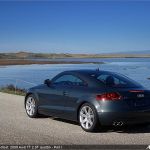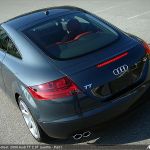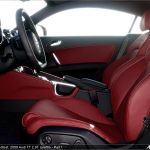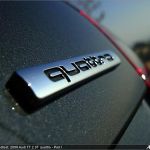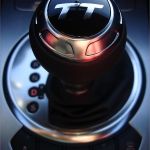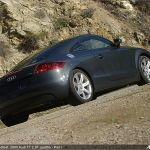2009 Audi TT 2.0T quattro
Flash forward to 2007 and the debut of a completely redesigned MK2 TT. Again the car grabbed my attention with its meaner looks and wider stance. As expected it inherited many of the iconic cues from the original, but I was fascinated with how much the design also echoed elements of the R8 supercar. Once again new TT’s grown-up look held a lot of promise as a driving machine.
A quick spin around the dealer’s block confirmed that this time it drove as well as it looked. The only problem was that my desired drivetrain combination, a 4 cylinder turbo with quattro, wasn’t available in the MK2’s first year. The single choice was a wheel-squealing FrontTrak for the 2.0T. If I wanted AWD I would have to get the more powerful yet less sophisticated VR6, a carryover from the outgoing TT. Although a great engine in its own right, its heft and lack of tunability just wasn’t right for me.
Again biding my time I got a short lease on an A4 and waited for the inevitable 2.0T quattro combo to hit market.
Finally a 2.0T quattro
2008 marked the announcement that all-wheel-drive would finally be paired with the 2.0T. I placed my order for an ’09 and loaded it to the brim with navigation, the trick Magnetic Ride, red leather, and of course quattro. It was just a matter of time for the Hungarians to assemble my special request car and for the journey across the Pacific to California.
Less Than a Dearth of Reviews
During the grueling 3 month wait for delivery I checked the internet and car magazines for what I thought would be at least some coverage of the new TT variant. Nothing. The perplexing lack of a 2.0T quattro drivetrain was pointed out in more than a few 2007 reviews, so it struck me as odd that the eventual availability of AWD for the killer 4 banger didn’t merit a single test drive. Then it dawned on me. The announcement of the hot TTS, which shared the same engine (with a bigger turbo of course) and drivetrain, stole the limelight away from the base 2.0T quattro’s significance.
So to set things right in the universe I decided to write a couple of comprehensive reviews of the 2.0T quattro TT. First up: Break-In.
“Your TT’s Here, Come and Pick it Up”
My fleet manager called on a Friday night to let me know my new ride made the trip intact to Santa Monica – some of the sweetest words I’ve ever heard.
I was a bit worried about not choosing the more aggressive S Line package in favor of the colored interior (you can’t get both in the US), but my fears evaporated immediately. The car was drop dead gorgeous. I found it to still be plenty aggressive, and as much as I love S Line, it looked cleaner without the body kit fuss. The Meteor Gray with the red interior work beautifully together. Meteor is just a great color, not as dark as Lava Gray or neutral as Dolphin due to its subtle blue ting.
First thing I did was pop on a pair of OEM chrome exhaust tips. My first mod. Although listed as standard in the brochure the non-S Line 2.0T’s don’t get exhaust bling. The procedure took all of 20 seconds since no tools were required. I can’t stress enough how much of an improvement the chrome brings to the back. This is a highly recommended modification and well worth it at about 100 bucks.
Interior
Inside the leather’s red leans slightly towards the muted orange so as to not get too obnoxious. Most agree it is striking, yet tasteful. With the TT being more of a performance coupe than a luxury cruiser, I was surprised at the very high level of quality materials lavishing the cockpit. The seat leather is extremely high quality, as are details like the textured headliner and felt-lined door pockets. This is without a doubt the best interior in its class.
The new TT’s interior design also takes a huge ergonomic step forward from the previous generation by offering a considerably more driver-oriented environment. The beautifully sculpted sport seats sit low with pedals and shifter easily reachable regardless of driver position. At over 6 feet tall I still have plenty of head and shoulder room. All steering wheel mounted controls, including the paddle shifters, are intuitively positioned and the flat-bottomed shape doesn’t interfere with quick turns. On the contrary the irregular shape helps the driver stay mentally oriented during mid-turn.
’09 upgrades include a sharper, brighter color Driver Information Display and a more attractive shifter design taken from the TTS. Both look great and directly benefit the driving experience.
The single interior annoyance comes from the tiny rear view mirror which offers a limited oval-shaped peak into the large hatchback rear window. Shifting in the seat just a bit requires mirror adjustment, something that can grow old quickly.
As far as tech is concerned the TT is no slouch with goodies like MMI-derived navigation, rear parking sensors and a dozen ways to get music piped through the Bose surround system. However it does lack some of the more up-to-the-minute gadgetry found in models like the new A4: items such as the superior B&O stereo, pushbutton start and backup camera. No matter; what the TT may lack in assorted cockpit gimmicks is more than made up by a suite of more meaningful drive technology.
Break In…
Oh wait, I almost forgot. One of the biggest automotive Debbie Downers is the break-in period. You get a fancy new sports car, and what’s the first thing you should do? Make sure to not push the car past 4000 RPM for the first 1000 miles. Damn.
So note that the following features were reviewed during the first 1000 miles of break in. But that doesn’t mean I didn’t cheat now and then…
quattro
Compared to the half dozen pre-’09 TT’s I tested, the quattro response in this new vehicle is decisively faster. In fact there’s no sense of a time delay between wheel slip and torque transfer to the rear wheels (by default the MK2’s system sends 85% of power to the front axle but can shift all 100% to the rear on call). I don’t know if this is the Gen 4 Haldex that was contractually exclusive to SAAB for a year before being released to Ingolstadt engineers last year, but my car does seem to exhibit the new system’s major advantage: the ability to proactively shift power between axels before slip instead of after.
To test the drivetrain further I completely switched off the two-stage ESP and tossed the car around an empty parking lot at around 7/10s (remember I was still breaking her in). The Haldex quattro felt just as predictable as the more evenly distributed Torsen system in my previous A4, which is saying a lot. There was no sense of unexpected (and unwelcome) computer correction during mid turn.
The car also felt extremely neutral. Without too much fuss I was able to get the back end to even spin out a bit. We’re not talking Mustang donuts here, but the fact that a quattro Audi can be coerced into any throttle-induced oversteer felt like a small miracle. I’m sure the combination of an aluminum intensive front end, lightweight 4 cylinder and rear-mounted AWD clutch helped balance out the car, but it was also clear that quattro did its part by quickly shifting torque to the rear wheels for more tail control. It’ll be interesting to push the car even further down the line.
Magnetic Ride
The option I think most worth the extra cash is Delphi’s performance oriented Magnetic ride. Unless you crave the visual look of an even lowered body or are a hard-core track junkie this technology renders the need for an aftermarket suspension pretty much irrelevant. With two settings you get the best of both worlds: a comfort mode that feels a touch softer than the TT’s stock setup and a Sport mode that firms things up considerably.
However it’s not simply the adjustability that makes this system a must-have, but just how brilliantly it responds to the road. Shock reaction times happen at a much faster rate than conventional systems and do so independently for each wheel. The overall effect is impressive; the car remains flat through very tight curves with little or no body pitching when recovering from more pronounced bumps. As you’d expect for a performance coupe you definitely feel the road, but more granular imperfections are smoothed out, especially in standard mode. The system is so good that I can confidently say it rivals anything offered by competitors like the Z4.
S Tronic
I was nervous about switching to an automatic after years of manual control, and would have flatly rejected a TT fitted with a traditional Tiptronic slush-box and its power draining torque converter. But the concept behind a dual clutch gearbox with manual transmission mechanicals felt worth the gamble, even if I didn’t fully warm up to the system on my test drives.
After a few days playing with the system I’m relieved to say that in many ways the S Tronic is better than a manual. Most notably it allows me to keep my hands on the wheel and foot on the throttle while shifting via paddles, a setup that works especially nicely around twisty roads where uninterrupted steering wheel grip is an advantage.
The gear shifts in automatic mode are indeed lightning fast as advertised, However manual control will only work as quickly if your choice of the next gear is in synch with the computer’s logic.
For example accelerating and sequentially manually pressing the ‘+’ paddle through the gear range at around 3000 RPM will yield silky smooth shifts. But if you decide to shift down from 5th to 4th while still in mid-acceleration, you’ll be greeted by a gentle but perceptible bump up in revs instead of a smooth gear transition to the next lower gear. That’s because that lower gear wasn’t pre-selected by the second clutch since the computer assumed you’d want to shift up during acceleration. This threw me off at first, but after a couple of days I got to understand the DSG’s logic and now rarely experience a rough shift. Now if I want to shift down from 5th to 4th I just let up on the throttle first and before shifting down.
The manual setting offers the least amount of computer intrusion I’ve ever experienced in any automated manual, including other DSG’s. As an example I was able to stay in first gear up to 7000 rpm before the computer decided I had lost my mind and intervened with an upshift.
Another cool DSG related feature is Launch Control, which enables the manual-like ability to rev up the engine while at a standstill for quick launches. To activate the feature one must first switch off traction control and set the gear shifter to either Sport or Manual mode. This may sound like an overly complex procedure but it’s not, especially since I’m usually driving around with that setup anyway. The stationary rev limit is only 3K, but enough for a neck snapping launch. The only unsettling part is pressing on the break and gas at the same time which is behavior we’ve all been conditioned to avoid with traditional transmissions. And I learned quickly to get my left foot off the break pedal following Launch Control since it invites the mistake of sudden accidental breaking. Not fun. Using the system I was able to get to 60 MPH in a hair under 6 seconds. Great numbers for a brand new stock 4 cylinder; which brings me to the last featured component, the engine.
2.0T Powerplant
I’ve enjoyed this brilliant inline turbo in my A4 for two years, so I was looking forward to seeing how it would fair in the way lighter TT. I was immediately struck by just how little lag the turbo exhibited for an automatic. My experience with older turbo engine/auto tranny combos led me to expect a longer delay between mashing of the throttle and forward motion. But the little turbo spools up very rapidly; power floods in fast and sticks around throughout most of the rev range with a smoothness comparable to many V6’s.
Another nice discovery was just how much power remains available at high speeds, especially for such a small displacement engine with a ‘mere’ 200 horsepower on tap. Dropping a gear or two and punching it for a quick 90 mph freeway pass is a non-issue. Then again the lightweight chassis does go a long way in freeing up engine power.
Engine sound in the front is similar to other 4 cylinder Audi’s, if just a bit less clunky. Nothing special. In the back the exhaust note does let out a somewhat throaty roar, but nowhere near the Boxter-like V6 burble heard off the back of the TT 3.2.
Exhaust sound reservations aside, this is the perfect engine for the TT. It is lightweight, responsive, and with power that starts early but stays with you at freeway speeds.
So after 10 years of waiting I’ve finally found my perfect TT: a gorgeous lightweight all-wheel-drive sports coupe whose drive finally matches its looks. In future articles I’ll push the car to higher levels of performance, test its utility and explore some software specific upgrades.
